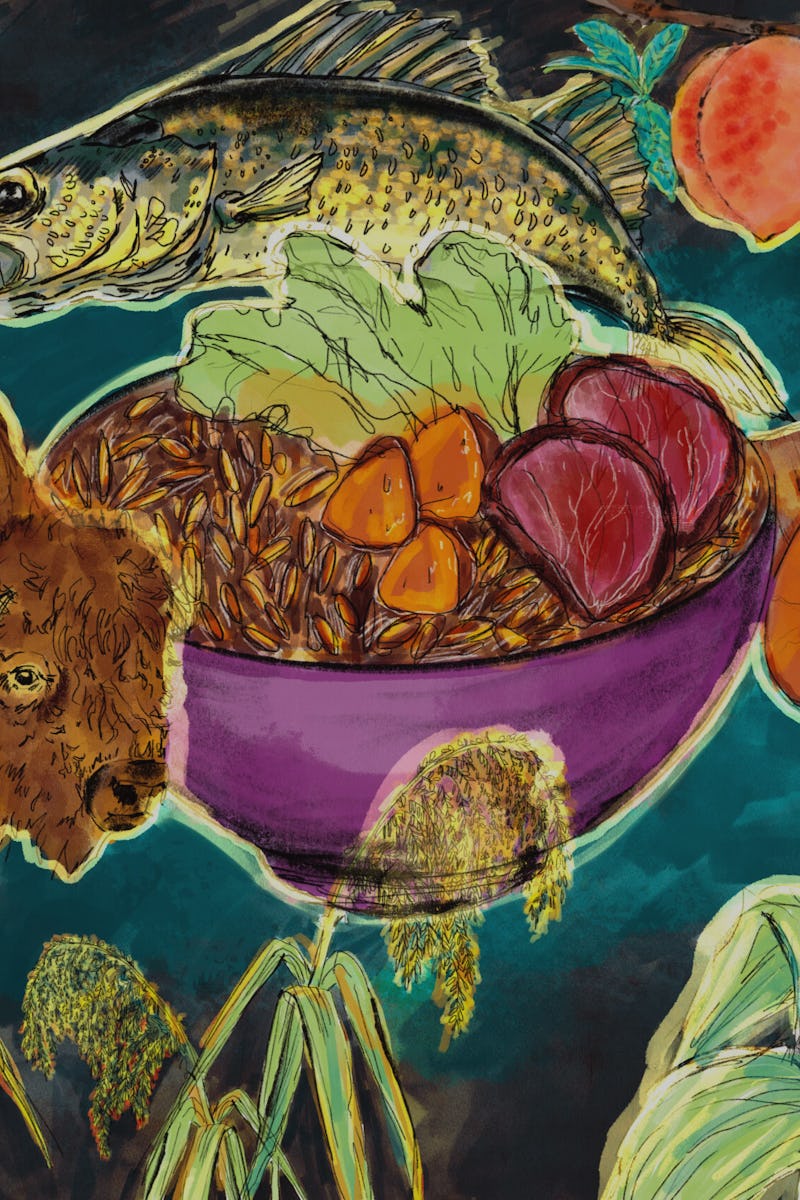
(OONA TEMPEST / KHN)
“The traditional diet seems more like a better diet.”
Indigenous diets: How one preschool is teaching kids to eat healthy
Bison pastrami is not typical school lunch fare, but it’s a crowd favorite at a preschool in Minneapolis.
by Katherine Huggins, Ariel Gans and Kaiser Health NewsMINNEAPOLIS — Bison pastrami is not typical school lunch fare, but it’s a crowd favorite at a preschool in Minneapolis.
Fawn Young bear-Tibbetts — the seemingly always on-the-go coordinator of Indigenous foods at the Wicoie Nandagikendan Early Childhood Urban Immersion Project — is frequently found tweaking recipes in the kitchen or offering homemade goodies like flourless black-bean brownies.
Young bear-Tibbetts, a longtime Minneapolis resident and member of the White Earth Band of the Minnesota Chippewa Tribe, has made it her mission to bring traditional recipes to the 178 children attending Wicoie, who are taught several hours each day in the Dakota and Ojibwe languages. She said the dishes not only help Native American students and their families connect with their culture, but also bolster their nutrition.
“Part of it is getting their palates [used to] eating traditional foods so that they want it,” she said. “Our kids are so used to eating all of this processed food — the snacks, the sugar.” She hopes students develop a taste for healthier food they will carry through their lives.
Across the breakfasts, lunches, and snacks Wicoie Nandagikendan serves, Young bear-Tibbetts incorporates sweet potatoes, fresh fruits, leafy greens, fish, and meat from large game animals like bison, which is extremely low in fat, she said. Recently, she distributed a donation of 300 pounds of bison to students’ families.
Bison meat is extremely low in fat.
Partly because of a lack of access to healthy food, nearly half of Native American children are overweight or obese, Indian Health Service researchers found in a study published in 2017.
A 2018 report from the First Nations Development Institute found that for “Native American children, their school or school-related meals may be the most reliable, consistent and nutritionally-balanced food they receive,” which Young bear-Tibbetts has found to be true.
Many children at the Minneapolis school come from families with severely limited incomes who may not have cars or be able to get to grocery stores. They often rely on convenience stores for shopping. “A lot of our kids only eat food at school so that’s when it becomes really important to make sure we’re serving the most nutritious” meals, Youngbear-Tibbetts said.
When money is tight, she added, “people tend to purchase the most calories they can with their dollars.”
“That’s potato chips, that’s ramen, that’s highly processed foods because there are more calories and it’s cheaper to buy it,” she said.
Youngbear-Tibbetts said many urban American Indian families never learned how to cook Indigenous food. She has taught students how to harvest wild rice and catch fish. She also has shown their families how to smoke and fillet fish.
“We have multiple generations of people and some families that are removed from even knowing how to clean a fish or how to cook deer meat,” she said.
“People tend to purchase the most calories they can with their dollars.”
Youngbear-Tibbetts grew up near Leech Lake, between the Minnesota cities of Grand Rapids and Bemidji, where her father taught her to harvest berries and greens, butcher deer, and catch walleye (a freshwater fish common in the northern United States) and whitefish.
By age 10, she said, she could butcher a deer or fillet a fish on her own. By 12, Youngbear-Tibbetts started cooking dinner for her family, partly because “if you cooked, you didn’t have to do the dishes.”
She began cooking regularly in high school after her mother grew sick.
“When she was diagnosed with diabetes, I went to her nutrition class with her,” Youngbear-Tibbetts said. “So that really changed how I ate and how I prepared foods.”
Youngbear-Tibbetts has cooked many of the recipes she serves students for most of her life, including venison, walleye, and meatballs made of turkey, bison, and wild rice. Sometimes she substitutes Indigenous ingredients for foods her students already enjoy. For example, she makes tacos with blue corn tortillas and bison instead of flour tortillas and beef.
She also teaches her students how to identify foods that grow in cities, like crabapples and mulberries, to incorporate into their diets.
Mulberry trees often grow in cities.
Native Americans are nearly three times as likely to develop diabetes than are non-Hispanic white Americans and 50% as likely to develop heart disease, according to federal data.
Dr. Mitchell LaCombe, a family physician at the Indian Health Board of Minneapolis, a community health clinic, said his patients face these issues regularly.
“I can tell people how to eat healthily, but if they can’t afford it or get it or acquire those medicines or those foods, then it doesn’t matter,” LaCombe said.
“The traditional diet seems more like a better diet,” LaCombe said, noting that “incorporating the Western-style diet is when things start to go sour. Especially when you get into the fast foods and the convenient foods that taste good.”
Ariel Gans and Katherine Huggins are Northwestern University graduate students in the Medill School of Journalism’s Washington, D.C., program.
KHN is a national newsroom that produces in-depth journalism about health issues. Together with Policy Analysis and Polling, KHN is one of the three major operating programs at KFF (Kaiser Family Foundation). KFF is an endowed nonprofit organization providing information on health issues to the nation.